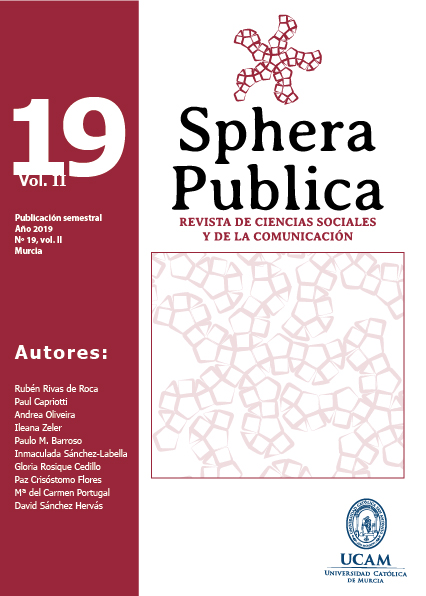Hyperreality and virtual worlds: when the virtual is real
Palabras clave:
hyperreality, image, real, virtual worlds, technologyResumen
This article questions what is hyperreality and underlines the role of the signs/images fostering the perception of a virtual world. It argues the potentiality of signs as artifacts. Starting from Agamben’s perspective regarding contemporary, the hyperreality is understood as a modern, visual and mass manifestation of the need for simulacra in a non-referential virtual world. How hyperreality, spectacle, simulation, and appearance emerge out of reality? What is authentic or real are issues raised using images and technological devices. The images are popular and amplify the effects of distraction and social alienation. The image is immediately absorbed, spectacular, attractive, a peculiar ready-to-think that eliminates or dilutes the concepts and produces a fast culture. Through a reflexive strategy, the purpose of this article is to problematize the experience of hyperreality, which is reshaping and restructuring patterns of social life and social interdependence, and the ways we see, think, feel, act or just mean and interpret the reality.
Citas
Agamben, G. (1998). Image et Mémoire. Paris: Editions Hoëbeke.
Agamben, G. (1999). Potentialities – Collected Essays in Philosophy. Stanford: Stanford University Press.
Agamben, G. (2007). The Coming Community. Minneapolis: University of Minnesota Press.
Agamben, G. (2009). What is an Apparatus? And Other Essays. Stanford: Stanford University Press.
Baudrillard, J. (1983). In the Shadow of the Silent Majorities – Or the End of the Social and Other Essays. New York: Semiotext(e).
Baudrillard, J. (1988a). America. London: Verso.
Baudrillard, J. (1988b). Symbolic Exchange and Death. Stanford: Stanford University Press.
Baudrillard, J. (1994). Simulacra and Simulation. Michigan: The University of Michigan Press.
Baudrillard, J. (2005). The Intelligence of Evil or the Lucidity Pact. Oxford: Berg Publishers.
Debord, G. (1995). The Society of the Spectacle. New York: Zone Books.
Deleuze, G. (1983). Plato and the Simulacrum. October, Vol. 27, pp. 45-56.
Deleuze, G. (1997). Cinema 2 – The Time-Image. Minneapolis: University of Minnesota Press.
Eco, U. (1986). Semiotics and the Philosophy of Language. Indiana: Indiana University Press.
Eco, U. (1998). Faith in Fakes – Travels in Hyperreality. London: Vintage.
Giddens, A. (1990). The Consequences of Modernity. Oxford: Basil Blackwell.
Han, B.-C. (2017). In the Swarm – Digital Prospects. Cambridge, Massachusetts: The MIT Press.
Heidegger, M. (1977). The Question Concerning Technology and Other Essays. New York: Garland Publishing.
Heidegger, M. (1982). On The Way To Language. New York: Harper & Row Publishers.
Hodge, E.; Collins, S. & Giordano, T. (2013). The Virtual Worlds Handbook – How to Use Second Life and Other 3D Virtual Environments. Massachusetts: Jones & Bartlett Publishers.
Lévy, P. (1999). ¿Qué es lo Virtual? Barcelona: Paidós.
Marx, K. & Engels, F. (1998). The German Ideology. New York: Prometheus Books.
McLuhan, M. (1967). The Medium is the Message. New York: Bentam Books.
Nietzsche, F. (2007). The Twilight of the Idols. London: Wordsworth Editions.
Perry, N. (1998). Hyperreality and Global Culture. London: Routledge.
Stolze, T. (2016). Contradictions of hyperreality: Baudrillard, Žižek, and Virtual Dialectics. International Journal of Žižek Studies (10-1), pp. 88-100.
Terashima, N. (2005). The definition of hyperreality. In John Tiffin & Nobuyoshi Terashima (org.), Hyperreality – Paradigm for the Third Millennium (pp. 4-24). New York: Routledge.
Tiffin, J. (2005). The hyperreality paradigm. In John Tiffin & Nobuyoshi Terashima (org.), Hyperreality – Paradigm for the Third Millennium (pp. 25-42). New York: Routledge.
Tiffin, J. & Terashima, N. (2005). Hypermillennium. In John Tiffin & Nobuyoshi Terashima (org.), Hyperreality – Paradigm for the Third Millennium (pp. 142-159). New York: Routledge.
Vattimo, G. (1992). The Transparent Society. Maryland: Johns Hopkins University Press.
Virilio, P. (1991). The Lost Dimension. Trans. Daniel Moshenberg. New York: Semiotext(e).
Woolley, B. (1993). Virtual Worlds: A Journey in Hype and Hyperreality. London: Penguin books.
Zizek, S. (2008). Violence – Six Sideways Reflections. New York: Picador.
Zizek, S. (2013). Interrogating the Real. London: Bloomsbury.
Descargas
Publicado
Cómo citar
Número
Sección
Licencia
Los autores que publican en esta revista están de acuerdo con los siguientes términos:- Los autores conservan los derechos de autor y garantizan a la revista el derecho de ser la primera publicación del trabajo al igual que licenciado bajo una Creative Commons Attribution License que permite a otros compartir el trabajo con un reconocimiento de la autoría del trabajo y la publicación inicial en esta revista.
- Los autores pueden establecer por separado acuerdos adicionales para la distribución no exclusiva de la versión de la obra publicada en la revista (por ejemplo, situarlo en un repositorio institucional o publicarlo en un libro), con un reconocimiento de su publicación inicial en esta revista.
- Se permite y se anima a los autores a difundir sus trabajos electrónicamente (por ejemplo, en repositorios institucionales o en su propio sitio web) una vez publicado en la plataforma de Sphera Publica, ya que puede dar lugar a intercambios productivos, así como a una citación más temprana y mayor de los trabajos publicados









